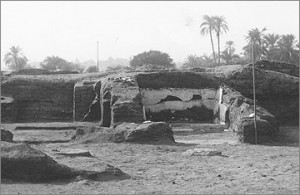Meryetaten’s Bathroom at Amarna

Meryetaten was the eldest daughter of Pharaoh Akhenaten, and lived some 33 centuries ago. She held an important place in her father’s court, apparently responsible for running his household, and became a queen later in her life. At the North Palace in her home city of Tell al-Amarna, there are many inscriptions bearing her name, which has led some scholars to the conclusion that this was her residence, although others ascribe a formal, ritual role to the palace. At the core of the complex is a throne-room, with small private apartments, including a bedroom and bathroom. In this session we will look at the location of the bathroom within the palace, and consider what it tells us about the private daily routine of the Amarna royals versus their public display of royal power.
Reading
[Blackboard Week 5 – Newton, Whittemore, Spence articles available as pdf’s]
For pictures and conservation work of the North Palace, see http://www.amarnaproject.com/pages/amarna_the_place/north_palace/index.shtml
The Amarna Trust newsletter Horizon 10 (2010): 2 : http://www.amarnatrust.com/newsletter.shtml
Newton, F.G.1924. Excavations at El-‘Amarnah, 1923–24, Journal of Egyptian Archaeology 10: 289-98.
Whittemore, T. 1926. The excavations at El-‘Amarnah, 1924–5, Journal of Egyptian Archaeology 12: 3-12.
Kemp, B.J. 2012. The City of Akhenaten and Nefertiti: Amarna and its People. London: Thames and Hudson, section on North Palace: 146-151.
Spence, K.E. 2009. The Palaces of el-Amarna: towards an architectural analysis, in Egyptian Royal Residences. 4th Symposium on Egyptian Royal Ideology, London, 1–5 June 2004 (R. Gundlach & J. Taylor eds). Königtum, Staat und Gesellschaft Früher Hochkulturen 4.1, 165–87. Wiesbaden: Harrassowitz.

Leave a Reply